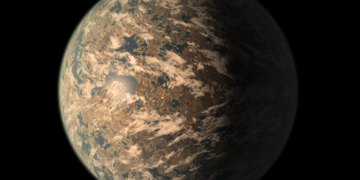For decades, astronomers have believed that planet-forming disks, the swirling clouds of gas and dust surrounding young stars, dissipate within 10 million years. These disks provide the raw materials for planet formation, shaping planetary systems as we know them. However, new observations by NASA’s James Webb Space Telescope (JWST) have turned this assumption upside down.
What Are Protoplanetary Disks? The Birthplace of Planets
The Foundations of Planet Formation
Before planets like Earth, Jupiter, or Saturn existed, their building blocks were part of a massive disk of gas and dust encircling the young Sun. These structures, known as protoplanetary disks, are observed around newly formed stars throughout the Milky Way.
How Long Do These Disks Last?
The conventional wisdom has been that most protoplanetary disks disperse within 10 million years due to:
- Radiation from the host star, which gradually blows away the gas and dust.
- Accretion processes, where material either forms planets or gets absorbed by the star.
- Collisions and interactions that break apart solid material in the disk.
However, JWST’s findings suggest that this process is not as universal as we once thought, especially for smaller, low-mass stars.
JWST’s Groundbreaking Discovery: A 30-Million-Year-Old Disk
Meet J0446B: A Star That Defied Expectations
The University of Arizona-led research team, using JWST’s advanced infrared capabilities, studied a low-mass star known as WISE J044634.16–262756.1B (J0446B), located 267 light-years away in the constellation Columba.
What they found was astonishing—this star still harbored a fully intact protoplanetary disk, despite being 30 million years old. This shatters previous estimates of disk longevity and raises crucial questions about planet formation around low-mass stars.
How Did JWST Make This Discovery?
JWST’s powerful infrared instruments, particularly the Mid-Infrared Instrument (MIRI) and Near-Infrared Spectrograph (NIRSpec), enabled astronomers to detect the chemical composition of the disk and determine whether it was truly a protoplanetary disk or merely debris.
- By detecting gases like hydrogen and neon, scientists confirmed that this was primordial material left over from the star’s formation—not a secondary debris disk.
- This means planet formation could still be happening in the system, millions of years beyond what we thought was possible.
Why Is This Discovery So Important?
1. Extending the Timeline for Planet Formation
A longer-lived disk means planets have more time to form. Previously, astronomers assumed that planets had a strict deadline of 10 million years to develop within their star’s disk. However, JWST’s findings suggest that planets in certain systems could have tens of millions of years more time to evolve.
This could be especially significant for larger gas giants like Jupiter, which require massive amounts of gas to form. If some disks persist for much longer than expected, then gas giants could form even in environments where we previously thought they wouldn’t have enough time.
2. A Potential Explanation for TRAPPIST-1’s Unique Planetary System
One of the most intriguing planetary systems discovered in recent years is TRAPPIST-1, a system with seven Earth-sized planets orbiting a red dwarf star, three of which are in the habitable zone.
Scientists have long wondered how such a tight, orderly planetary system could form. The answer may lie in long-lived disks—if disks last longer around low-mass stars, then planets have more time to migrate into stable orbits, explaining why TRAPPIST-1’s planets are packed so closely together.
This means that JWST’s discovery could reshape how we understand exoplanet system architecture, especially around small stars.
3. Implications for Habitability and Alien Life
Since low-mass stars vastly outnumber Sun-like stars in the galaxy, their planetary systems could be some of the most common places where life might emerge.
- A longer disk lifespan means more stable conditions for planets to develop atmospheres and oceans.
- If water-rich worlds have more time to form, then the chances of habitability increase.
This discovery, therefore, makes red dwarf systems even more attractive targets for future searches for life beyond Earth.
How Does This Change Our Understanding of Planet Formation?
A Challenge to Existing Theories
JWST’s findings disrupt the conventional planet formation model in two major ways:
- Longer-lived disks mean planets can form in environments we previously ruled out.
- Chemical compositions of older disks remain surprisingly stable, suggesting that conditions for planet formation don’t degrade over time as much as we assumed.
Astronomers will now have to revise models of how planets form and migrate, particularly for low-mass stars that dominate our galaxy.
What’s Next? Future Research Directions
This discovery opens up several new questions that astronomers will investigate in the coming years:
- How common are these long-lived disks? Are they rare cases, or do many low-mass stars retain their disks longer than expected?
- Do these disks still form planets, or do they eventually stagnate?
- Could long-lived disks influence the chemical composition of newly formed planets?
Conclusion: A Paradigm Shift in Planetary Science
NASA’s James Webb Space Telescope has once again reshaped our understanding of the universe. The revelation that planet-forming disks can persist for much longer than previously thought challenges existing theories about how planetary systems evolve and expands the possibilities for habitable exoplanets.
Reference:
Feng 凤 Long 龙 et al, The First JWST View of a 30-Myr-old Protoplanetary Disk Reveals a Late-stage Carbon-rich Phase, The Astrophysical Journal Letters (2025). DOI: 10.3847/2041-8213/ad99d2



















